Last Updated on July 11, 2023
Arizona Swimming Pool Code & Lock Requirements
Here in Arizona, home of Acme Locksmith, a good percentage of homes have in-ground swimming pools. We have the perfect climate for them, and having a swimming pool means you can entertain in another space at your home almost the whole year round. But a swimming pool can also be a hazard source, and each year we hear in the news of drownings; the saddest instances are when a small child is lost to a pool drowning.
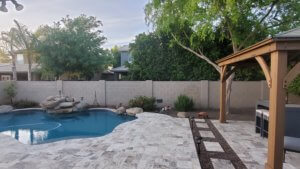
For this reason, the State of Arizona, and Arizona cities, have building codes in effect for homes that have above-ground and in-ground swimming pools, applicable to all new construction and, generally, in the sale or transfer of existing homes.
For Arizona, the pool code is found in statute A.R.S. 36-1681.
There are various requirements depending on the pool barrier classification, but in the most general terms, the Arizona pool code requirements are as follows:
- A barrier exist around the entire pool. This pool barrier can be either:
- The barrier be at least 5 feet tall
- All accesses to the pool area be self closing (such as a gate or door)
- Those accesses be self latching so once closed, they must be unlatched to enter
- Those accesses require the unlatching device to be over 54″ high
- Depending on the barrier type, there may be additional requirements (discussed in detail below).
There are different specifications which apply to different pool situations, but each pool code compliance situation has lock solutions that ACME Locksmith, or your local locksmith, can help with. We’ll go over some scenarios to help you understand the code and find the pool security products that apply to your situation.
Code requirements can seem complicated, as in fact they are, and every city’s pool code is slightly different in their requirements. These then must be compared to superior code requirements (such as county or state), with the more restrictive taking precedence. We cannot cover all code situations, but we can cover some common situations related to pool barrier code and suggest solutions. The metrics we will use for these examples follow the Arizona Revised Statute figures; actual figures may be different for your city.
Barrier Code for Free-Standing Pool Fences
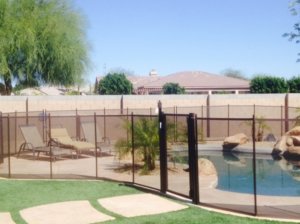 For free-standing pool fences and walls, attached to no buildings but simply surrounding the pool (whether or not the yard fence is a portion of this barrier) then, in addition to specifications regarding the barrier itself, any gate leading to the pool must be self-closing and self-latching. It also must open outward from the pool (away from the pool).
For free-standing pool fences and walls, attached to no buildings but simply surrounding the pool (whether or not the yard fence is a portion of this barrier) then, in addition to specifications regarding the barrier itself, any gate leading to the pool must be self-closing and self-latching. It also must open outward from the pool (away from the pool).
The latch must be:
- At least 54 inches above the ground if mounted on the outside portion of the gate or
- At least 5 inches below the top of the gate if it is mounted on the inside portion.
- There shall not be any gaps within 24 inches of the latch with openings greater than ½ inch
- UNLESS there is a lock securing the gate, such as a padlock or other similar device, which requires a key, electric opener, or other integrated combination. In which case it may be mounted at any height.
The 54 inch rule is to keep little hands away from opening gates. You’ll notice a common thing in swimming pool codes: everything is geared to keep small children out of harms way.
The ½ inch opening rule is to keep little fingers from reaching in and working the latch.
Keyed locks, however, mean little fingers aren’t useful in defeating them, so it creates a situation where the height standards and gap standard of ½ inch can be relaxed.
One thing to note. Even free-swinging gates that latch at the top in accordance to the code need to be looked at. Metal pool gates have a HUGE flaw that allows them to be opened from the bottom of a gate, exactly where a small child would be. Check out this YouTube video highlighting the issue. If you have this type of gate, you need to be sure to lock it.
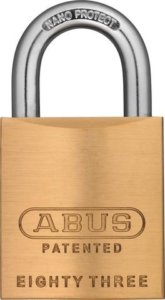
The least expensive solution to secure this and other gates would be a padlock or other keyed/combinated lock, because the ‘UNLESS’ frees the end user from some of the restrictions that may add cost.
ACME Locksmith sells padlocks which can be keyed to match your home for a reasonable cost, making this a convenient option as well. Our favorite is from ABUS, you can find them on Amazon here. Just be sure to order the lock that is the same as your home keyway, then bring it into your local locksmith shop to key it up to your house key.
Combination padlocks are acceptable, too, and ACME Locksmith carries several styles at all of our locations. We like this one from Master Lock (here on Amazon) because it’s super easy to use on a gate like this, very affordable, and security is not an issue (just safety). It relies on movements instead of having to dial a combination.
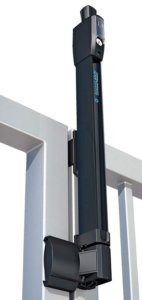
There are some great after-market latches as well that can be mounted on a variety of tubular gate styles which either match the height thresholds, or provide keyed access.
Our favorites is the Magna Lock sold on Amazon because the lock release is very high up and out of reach. The Magna Lock is what I used on my pool fence, and I loved it. This, and other auto-latching options, are easily found under $100.
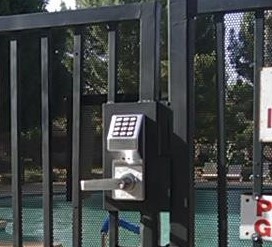
For metal gates, like those found in community pools, more robust options exist including gate systems with gate-latching deadbolts or keyless entry locks that are installed into gate boxes that have been welded in. We cover many of these options in our article “How to Lock a Gate for details.” For the self-closing requirements, most residential pool gates use spring hinges. These are often the easiest and least expensive solutions. We love the True Close Pool Gate Hinge. They seem to last forever and are easy to install (see them on Amazon).
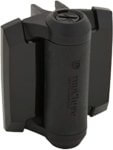
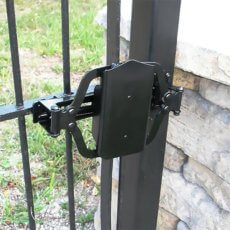
For commercial pool gates, stronger tension-spring kits are available. Or better yet, gate closers, such as the KantSlam shown here on Amazon, ensure the pool gate closes without it slamming.
If you need help installing any of these pool gate locks or gate closers, we offer gate lock and welding services can take care of you if you’re in AZ, otherwise your local locksmith can help in other areas..
Regardless the solution selected, upon self-closing the gate must latch closed, by itself, to be compliant to code.

.
Code for Pool Barriers Where Perimeter Fencing is a Portion of the Barrier
In this situation, part of the wall surrounding the property acts as the pool barrier, but no part of the home itself is a part of the barrier. For the most part, this is the same as the code for stand alone pool fencing above. The caveat is that ANY other property access gate that is along the perimeter wall leading into the pool area also need to have the same locking standards above.
Also note, some cities have more restrictive fencing requirements for property fencing than the 5′ mentioned above. Chandler’s fence requirement is 6′. Always refer to your city’s specific codes.
If this situation involves larger gates used to allow vehicle storage, these gates are not exempt from the Arizona pool code requirements (in fact, in some areas, there are more strict requirements for these gates). Since they are much larger than pedestrian gates, getting them up to code for self-latching and self-locking reliably can be a challenge.
In some municipalities, the self close/latch requirement can be waived if the gate is kept secured with a padlock at all times unless in use, but some places DO require at least one leaf of the gate to self close against an ‘inactive’ leaf (usually secured in place with a pole that inserts into the ground).
In places which allow it, a simple padlock is certainly the least expensive solution (check out our links shown above) as larger gates weigh more, and getting them to self-close and latch consistently can be nearly impossible on poorly constructed gates. A gate company may be needed if this is the case.
If, on the other hand, the gate works wonderfully and just needs to be secured for pool code compliance, many locksmiths can do welding modifications to add self-locking gate latches or address the self-closing aspect with heavy-duty gate closer devices.
Code for Pool Barriers Where Part of the Home Acts as a Barrier
This situation is the most involved barrier situation. In order to meet code, every exit from the residence and every window which opens to the pool area must be secured and, in some regions, even alarmed.
When a door is present, leading from the home into the pool area, there are a few solutions that can be used to meet the self latching code.
These doors must be self-closing and self-latching, as before. Common household doors can achieve this with the use of spring hinges or simple door closers designed for light-use applications.
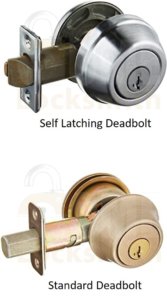
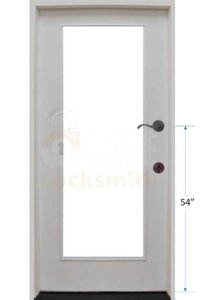
Self latching “gate” deadbolts can be used to auto-latch the door closed. In a traditional deadbolt, the deadbolt has to be “thrown” to be used. That is, manually locked. But gate latching deadbolts have latches like those found in knobs and levers. These will auto lock when the door is closed and if auto-locking is required by city pool code, a double sided deadbolt with a gate latch is ideal. Here are gate latch deadbolts on Amazon.
Another idea that is often used in Arizona is to install the knob or the lever in the hole originally designed for the deadbolt and move the deadbolt down to the lower hole. With the lever installed up high, you will meet the self latching code so long as that hole is 54″ high. If it is not, the door will need to be drilled to support a self-latching lock that meets the pool code height. Your local locksmith can do this for you.

.
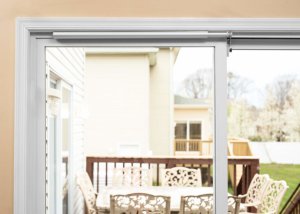
If code allows for it, a self latching double cylinder deadbolt (one that is keyed on both sides) could replace an existing single cylinder deadbolt (one that has a thumb-turn on the inside) without needing to change the location. These are self locking and would require a key to open the lock from the inside of the home. Remember, ‘keyed’ or ‘combination’ locks eliminate the code’s lock height requirement. Check with your city.
By code, sliding glass doors (also called Arcadia doors) need to also be self-closing as well if you can access the pool by going through the door. There are kits available for home installation on Amazon that can satisfy this need, or your local sliding glass door company can install them. Most locksmiths in AZ do not install them. Codes vary on patio style doors; you may also need to add ancillary keyed or height-appropriate latches to these doors as well.
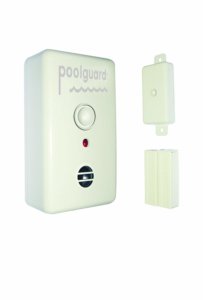
Further still (or in some cases, in place of), some Arizona cities require some type of door alarm on all doors leading to the pool. Usually these need to be loud enough to be heard throughout the home when the door is opened, and each municipality is very particular in what features these alarms have. There are many home door alarms that will NOT satisfy your local code requirements. Typically, when required, the local code will specify an “ANSI” standard. ANSI is the American National Standards Institute, and their purpose is to provide standards which manufacturers must meet in order to sell their products as compliant to a given need.
If your city pool code has one, you want to be sure you buy a product that is listed as meeting that standard, or you may wind up still out of compliance after installation. But the installation of these is usually pretty straight-forward and many homeowners can install these themselves. If not, locksmiths can install these for you.
Open door / window alarms are readily available on Amazon.
Windows must be secured, also. One way to achieve this is permanent exterior window screens screwed in place with wire-mesh screens. But alternatively, ancillary locks or latches can be installed; these usually need to be either keyed, or located higher than 54 inches, and designed to inhibit a window from opening more than 4 inches. We recently wrote an article on “How to Secure Windows”, you can view the many options there for a solution to your need.
Other Pool Security Options
There are, of course, other situations and resolutions for pool security, such as permanent installation pool covers, situations and requirements for above-ground pools, and possible zoning exemptions for some communities.
We’ve tried here to address some of the most common concerns, and solutions for them, but the breadth of the topic means that not all situations can be conveyed in a blog such as this one. As such, here are several links to some of the major Arizona City Pool Code Compliance documents.
City Links for Arizona Pool Code Regulations
For further references in the Maricopa County, Arizona region, here are some links to relevant pool codes in the larger communities:
Arizona Revised Statute 36-1681: Pool Enclosures; requirements; exceptions; enforcement
Maricopa County Fence, Wall, and Pool Barrier Requirements (PDF)
Town of Gilbert Swimming Pool Code (4.107)
Scottsdale Arizona Municipal Code Pool Code (Sec 31-68)
City of Tempe Private Outdoor Swimming Pool Barrier Enclosure Requirements
City of Mesa Swimming Pool Code (PDF)
City of Phoenix Pool Code Policy
Peoria Swimming Pool and Spa Barrier Code
Glendale Arizona Code of Ordinances Ch32, Swimming Pools
Chandler Arizona Pool Barrier Guidelines (PDF)
Surprise Arizona Residential Swimming Pool Requirements – Uses the 2018 International Residential Code
Avondale Swimming Pool Requirements
International Building Code for Swimming Pools (2009, PDF)
Disclosure: As an eBay / Amazon / Alibaba Associate I may earn from qualifying purchases.
